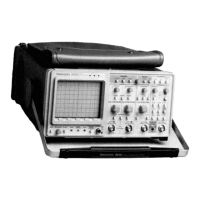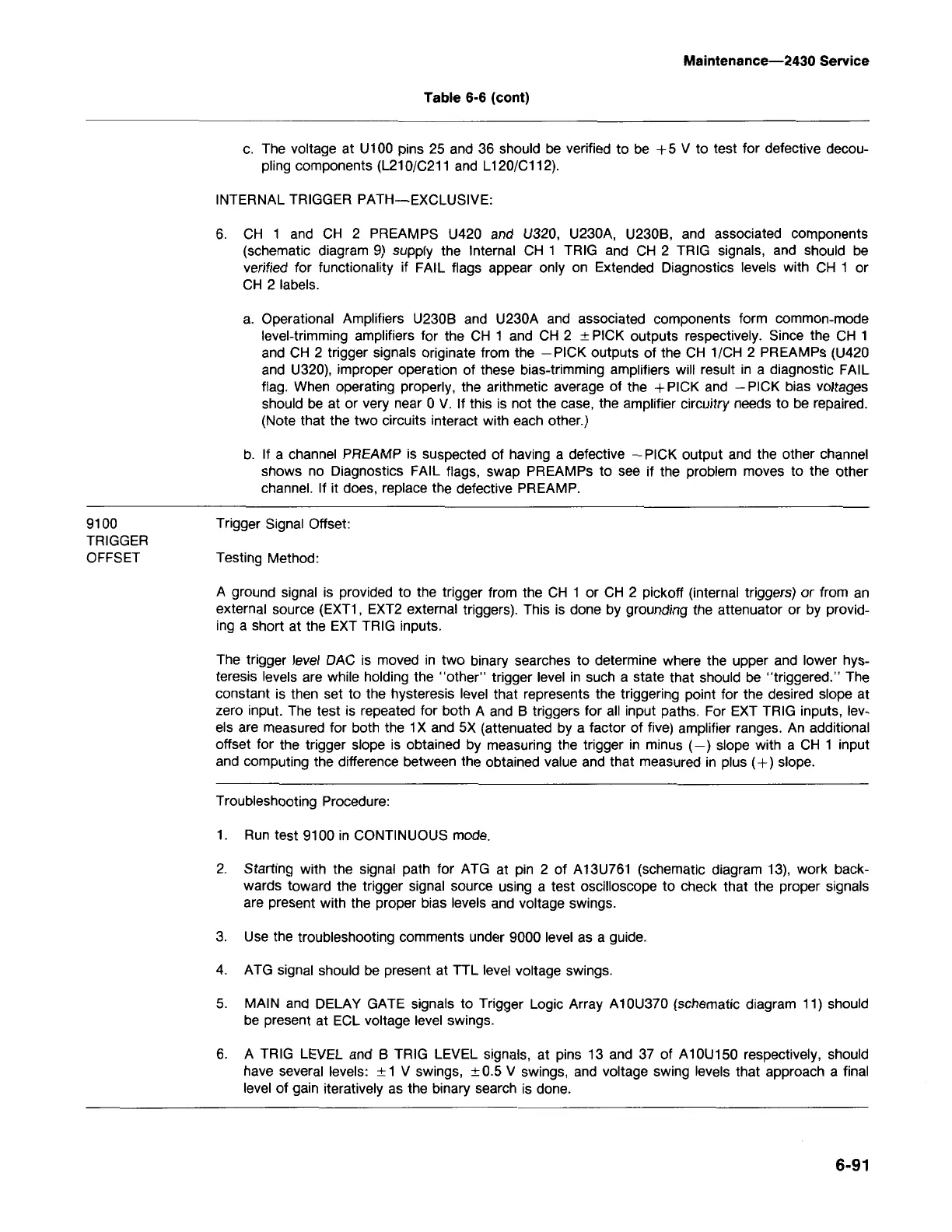6-91
6. A TRIG LEVEL and B TRIG LEVEL signals, at pins 13 and 37 of A10U150 respectively, should
have several levels:
±
1 V swings,
±
0.5 V swings, and voltage swing levels that approach a final
level of gain iteratively as the binary search is done.
5. MAIN and DELAY GATE signals to Trigger Logic Array A10U370 (schematic diagram 11) should
be present at ECL voltage level swings.
4. ATG signal should
be
present at TTL level voltage swings.
3. Use the troubleshooting comments under 9000 level as a guide.
2. Starting with the signal path for ATG at pin 2 of A13U761 (schematic diagram 13), work back-
wards toward the trigger signal source using a test oscilloscope to check that the proper signals
are present with the proper bias levels and voltage swings.
1. Run test 9100 in CONTINUOUS mode.
Troubleshooting Procedure:
The trigger level DAC is moved in two binary searches to determine where the upper and lower hys-
teresis levels are while holding the "other" trigger level in such a state that should be "triggered." The
constant is then set to the hysteresis level that represents the triggering point for the desired slope at
zero input. The test is repeated for both A and B triggers for all input paths. For EXT TRIG inputs, lev-
els are measured for both the 1X and 5X (attenuated by a factor of five) amplifier ranges. An additional
offset for the trigger slope is obtained by measuring the trigger in minus (-) slope with a CH 1 input
and computing the difference between the obtained value and that measured in plus (+) slope.
A ground signal is provided to the trigger from the CH 1 or CH 2 pickoff (internal triggers) or from an
external source (EXT1, EXT2 external triggers). This is done by grounding the attenuator or by provid-
ing a short at the EXT TRIG inputs.
Testing Method:
Trigger Signal Offset:9100
TRIGGER
OFFSET
b. If a channel PREAMP is suspected of having a defective - PICK output and the other channel
shows no Diagnostics FAIL flags, swap PREAMPs to see if the problem moves to the other
channel. If it does, replace the defective PREAMP.
a. Operational Amplifiers U230B and U230A and associated components form common-mode
level-trimming amplifiers for the CH 1 and CH 2
±
PICK outputs respectively. Since the CH 1
and CH 2 trigger signals originate from the -PICK outputs of the CH 1/CH 2 PREAMPs (U420
and U320), improper operation of these bias-trimming amplifiers will result in a diagnostic FAIL
flag. When operating properly, the arithmetic average of the +PICK and -PICK bias voltages
should
be
at or very near 0 V. If this is not the case, the amplifier circuitry needs to be repaired.
(Note that the two circuits interact with each other.)
6. CH 1 and CH 2 PREAMPS U420 and U320, U230A, U230B, and associated components
(schematic diagram 9) supply the Internal CH 1 TRIG and CH 2 TRIG signals, and should
be
verified for functionality if FAIL flags appear only on Extended Diagnostics levels with CH 1 or
CH 2 labels.
INTERNAL TRIGGER PATH-EXCLUSIVE:
c. The voltage at U100 pins 25 and 36 should
be
verified to
be
+5 V to test for defective decou-
piing components (L210/C211 and L120/C112).
Table 6-6 (cont)
Maintenance-2430 Service

